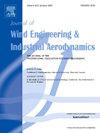Experimental study on hazardous gases and dust removal under forced ventilation in inclined construction tunnels after blasting
IF 4.9
2区 工程技术
Q1 ENGINEERING, CIVIL
Journal of Wind Engineering and Industrial Aerodynamics
Pub Date : 2025-08-30
DOI:10.1016/j.jweia.2025.106217
引用次数: 0
Abstract
Pollutant control during tunnel construction differs from that during operation due to the presence of one closed end. Tunnel construction blasting generates significant amount of pollutant gases and inhalable particulate matter, posing health and safety risks to workers. This study performed reduced-scale experiments to investigate the transport of pollutants under forced ventilation after blasting. 1:15 scaled model experiments were performed with emphasis on the effects of inclination and ventilation air volume. The pollutant removal efficiency was assessed based on pollutant removal time, local time-weighted average concentration, and the areal time-weighted average concentration. The results show that ventilation air velocity should be selected according to inclination. Positive tunnel inclinations may cause secondary recirculation of pollutants. The pollutant removal time decreases with increasing air velocity and decreasing inclinations from 5° to −5°. The local time-weighted average concentration of pollutants is significantly higher under positive inclinations than under negative inclinations. The areal time-weighted average concentration of CO is primarily influenced by inclination. For PM2.5, although inclination has a greater impact, ventilation air volume also contributes to its variation. The correlations of dimensionless pollutant removal time with inclination and ventilation air volume were proposed for negative and positive inclinations, respectively. PM2.5 has a longer removal time than CO. These findings provide guidance on pollutant control and ventilation system design under forced ventilation in tunnel construction after blasting.
倾斜施工隧道爆破后强制通风下有害气体及粉尘的除尘试验研究
隧道施工期间的污染控制与运行期间的污染控制不同,因为存在一个封闭的末端。隧道工程爆破产生大量的污染气体和可吸入颗粒物,对工人的健康和安全构成威胁。本研究采用小尺度实验研究爆破后强制通风条件下污染物的运移。进行了1:15比例模型实验,重点研究了倾斜度和通风风量的影响。根据污染物去除时间、局部时间加权平均浓度和区域时间加权平均浓度评价污染物去除效率。结果表明,通风风速应根据倾斜度选择。正向的隧道倾斜度可能引起污染物的二次再循环。在5°~ - 5°范围内,随着风速的增大和倾斜度的减小,污染物去除时间减小。当地污染物的时间加权平均浓度在正向倾斜下显著高于负向倾斜下。CO的面时间加权平均浓度主要受倾角的影响。对于PM2.5,虽然倾斜度影响较大,但通风量对其变化也有影响。在负倾斜和正倾斜情况下,提出了无量纲污染物去除时间与倾斜度和通风量的相关关系。PM2.5的去除时间比CO长。研究结果对爆破后隧道施工强制通风条件下的污染物控制和通风系统设计具有指导意义。
本文章由计算机程序翻译,如有差异,请以英文原文为准。
求助全文
约1分钟内获得全文
求助全文
来源期刊
CiteScore
8.90
自引率
22.90%
发文量
306
审稿时长
4.4 months
期刊介绍:
The objective of the journal is to provide a means for the publication and interchange of information, on an international basis, on all those aspects of wind engineering that are included in the activities of the International Association for Wind Engineering http://www.iawe.org/. These are: social and economic impact of wind effects; wind characteristics and structure, local wind environments, wind loads and structural response, diffusion, pollutant dispersion and matter transport, wind effects on building heat loss and ventilation, wind effects on transport systems, aerodynamic aspects of wind energy generation, and codification of wind effects.
Papers on these subjects describing full-scale measurements, wind-tunnel simulation studies, computational or theoretical methods are published, as well as papers dealing with the development of techniques and apparatus for wind engineering experiments.

 求助内容:
求助内容: 应助结果提醒方式:
应助结果提醒方式:


